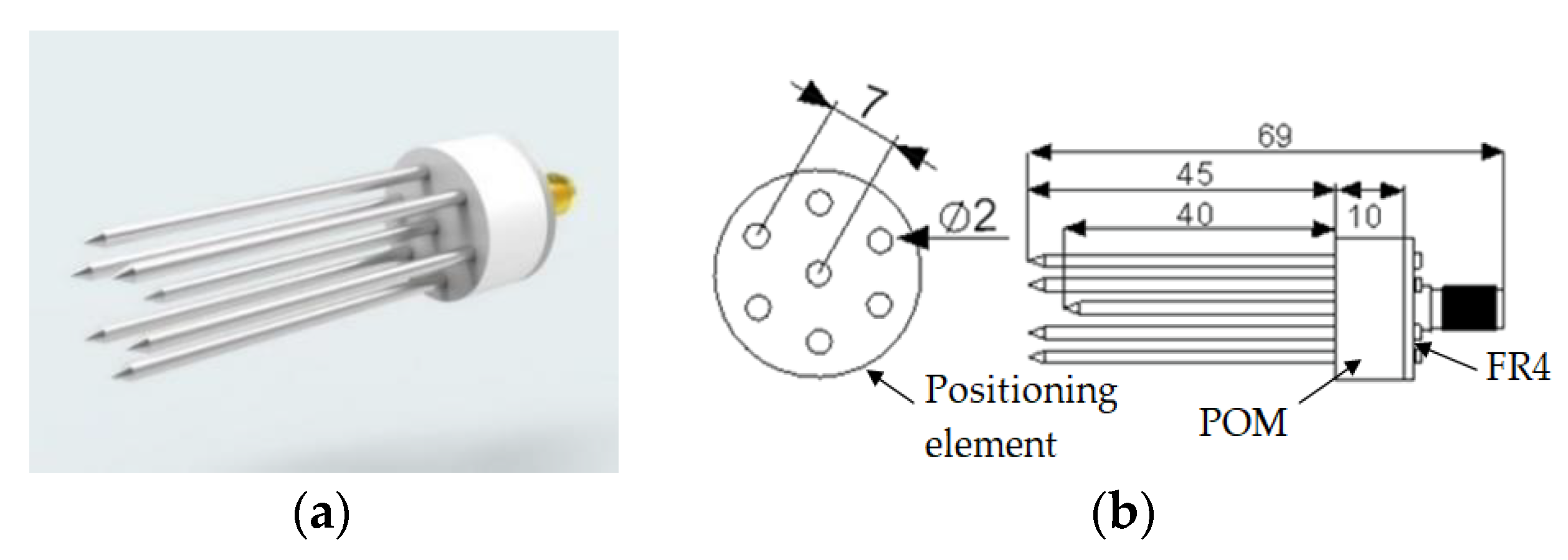Seven-Rod Dielectric Sensor for Determination of Soil Moisture in Small Volumes †
Abstract
:1. Introduction
2. Materials and Methods
2.1. Determination of the Sensitivity Zone
2.2. Soil Samples Measurement
3. Results and Discussion
4. Conclusions
Funding
References
- Jones, S.B.; Blonquist, J.M.; Robinson, D.A.; Rasmussen, V.P.; Or, D. Standardizing characterization of electromagnetic water content. Vadose Zone J. 2005, 4, 1048–1058. [Google Scholar] [CrossRef]
- Skierucha, W.; Wilczek, A. A FDR Sensor for Measuring Complex Soil Dielectric Permittivity in the 10–500 MHz Frequency Range. Sensors 2010, 10, 3314–3329. [Google Scholar] [CrossRef] [PubMed]
- Skierucha, W.; Wilczek, A.; Szypłowska, A.; Sławiński, C.; Lamorski, K. A TDR-Based Soil Moisture Monitoring System with Simultaneous Measurement of Soil Temperature and Electrical Conductivity. Sensors 2012, 12, 13545–13566. [Google Scholar] [CrossRef] [PubMed]
- Robinson, D.A.; Campbell, C.S.; Hopmans, J.W.; Hornbuckle, B.K.; Jones, S.B.; Knight, R.; Ogden, F.; Selker, J.; Wendroth, O. Soil Moisture Measurement for Ecological and Hydrological Watershed-Scale Observatories: A Review. Vadose Zone J. 2008, 7, 358–389. [Google Scholar] [CrossRef]
- Xu, J.; Ma, X.; Logsdon, S.D.; Horton, R. Short, Multineedle Frequency Domain Reflectometry Sensor Suitable for Measuring Soil Water Content. Soil Sci. Soc. Am. J. 2012, 76, 1929–1937. [Google Scholar] [CrossRef]
- Kafarski, M.; Wilczek, A.; Szypłowska, A.; Lewandowski, A.; Pieczywek, P.; Janik, G.; Skierucha, W. Evaluation of Apple Maturity with Two Types of Dielectric Probes. Sensors 2018, 18, 121. [Google Scholar] [CrossRef] [PubMed]
- Buckley, F.; Maryott, A.A. Table of Dielectric Dispersion Data for Pure Liquids and Dilute Solutions; Bureau of Standards Circular: Washington, DC, USA, 1958; pp. 1–101. [Google Scholar]
- Liu, C.; Zhang, L.; Peng, J.; Srinivasakannan, C.; Liu, B.; Xia, H.; Zhou, J.; Xu, L. Temperature and moisture dependence of the dielectric properties of silica sand. J. Microw. Power Electromagn. Energy 2013, 47, 199–209. [Google Scholar] [CrossRef] [PubMed]
- Topp, G.C.; Davis, J.L.; Annan, A.P. Electromagnetic determination of soil water content: Measurements in coaxial transmission lines. Water Resour. Res. 1980, 16, 574–582. [Google Scholar] [CrossRef]
- Roth, K.; Schulin, R.; Fluhler, H.; Attinger, W. Calibration of time domain reflectometry for water content measurement using a composite dieletric approach. Water Resour. Res. 1990, 26, 2267–2273. [Google Scholar]



| Texture [%] | |||
|---|---|---|---|
| Clay | Silt | Sand | |
| SKR | 3.7 | 28.8 | 67.5 |
| GRT | 10.1 | 76.5 | 13.4 |
© 2020 by the authors. Licensee MDPI, Basel, Switzerland. This article is an open access article distributed under the terms and conditions of the Creative Commons Attribution (CC BY) license (https://creativecommons.org/licenses/by/4.0/).
Share and Cite
Szerement, J.; Woszczyk, A.; Szypłowska, A.; Kafarski, M.; Lewandowski, A.; Wilczek, A.; Skierucha, W. Seven-Rod Dielectric Sensor for Determination of Soil Moisture in Small Volumes. Proceedings 2019, 15, 49. https://doi.org/10.3390/proceedings2019015049
Szerement J, Woszczyk A, Szypłowska A, Kafarski M, Lewandowski A, Wilczek A, Skierucha W. Seven-Rod Dielectric Sensor for Determination of Soil Moisture in Small Volumes. Proceedings. 2019; 15(1):49. https://doi.org/10.3390/proceedings2019015049
Chicago/Turabian StyleSzerement, Justyna, Aleksandra Woszczyk, Agnieszka Szypłowska, Marcin Kafarski, Arkadiusz Lewandowski, Andrzej Wilczek, and Wojciech Skierucha. 2019. "Seven-Rod Dielectric Sensor for Determination of Soil Moisture in Small Volumes" Proceedings 15, no. 1: 49. https://doi.org/10.3390/proceedings2019015049
APA StyleSzerement, J., Woszczyk, A., Szypłowska, A., Kafarski, M., Lewandowski, A., Wilczek, A., & Skierucha, W. (2019). Seven-Rod Dielectric Sensor for Determination of Soil Moisture in Small Volumes. Proceedings, 15(1), 49. https://doi.org/10.3390/proceedings2019015049





